Some Common Indian Customs & Traditions
|
"When you judge my religion you take it that yours is perfect and mine
wrong; and when you criticise the society of India you suppose it to be
uncultured just so far as it does not conform to your standard. That is
nonsense."
(Boston Herald, May 15, 1894, reporting a lecture by Swami Vivekananda)
- It still applies today.
|
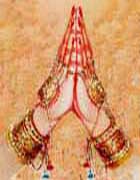
|
India is a land of often bewildering diversity. It is a jigsaw puzzle of
people of every faith and religion, living together to create a unique
and colourful mosaic. Different parts of India follow different customs.
Generally the big cities are more liberal and cosmopolitan. But as one
travels inward one comes across customs preserved through history. The
philosophy of life is very different from that of the West. Indians are
hospitable people. Here are a few tips for day-to-day life:
|
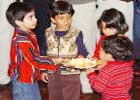 |
Aarti is performed as an act of veneration and love. It is often performed
as a mark of worship and to seek blessings from God, to welcome the guests,
for children on their birthdays, family members on auspicious occasions or
to welcome a newly wedded couple.
The purpose of performing aarti is to ward off evil effects and malefic
influence of the evil eye. For performing aarti, five small lamps
called Niranjanas are filled with oil or clarified butter (ghee)
and arranged in a small metallic tray. A cotton wool wick is placed
in the lamps. A conch-shell filled with water, auspicious leaves or
flowers, incense or lighted camphor are also placed on the tray.
The lamps are lit and the tray is rotated in a circular motion in front
of the deity or the person to be welcomed.
|
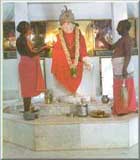 |
 |
A bindi is an auspicious mark worn by young girls and women. It is usually a
red dot made with Vermillion powder which is worn by the women between their
eyebrows on their forehead. Traditionally a symbol of marriage, it has
become decorative and is worn today by unmarried girls and women as well.
No longer restricted to colour or shape, bindis are seen in many bright colours
and in different shapes and designs. They are also made of coloured felt and
embellished with coloured glass or glitter.
|
Fixed Price
Today cash.
Tomorrow on Credit. |
Fixed price is charged in recognised shops, government emporiums and
department stores. In all other places especially in bazaars, rickshaws
and taxis, bargain for a lesser price. It is a fairly common practice.
|

|
In India women are expected to dress modestly.
Short skirts and tight or revealing clothes should not be worn, even on
beaches, unless it is meant for swimming.
|
 |
Business people are not expected to dress formally except for meetings and
social functions.
|
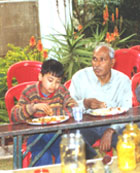 |
In India it is usual to eat with the hand. It is essential that only the
right hand is used for eating. The left hand is considered "not clean".
It is no offence to ask for fork and spoon. Knives are generally not used.
|
 |
In some families it is customary to remove the shoes before entering a house.
Because of strict religious and social customs visitors must show particular
respect when visiting someone's home.
|

 |
All visitors are asked to remove footwear when entering places of religious
worship. Gurudwaras (Sikh temples) will also require the visitor to cover
the head. Dress properly to visit the places of worship be it a temple,
gurudwara or a mosque. Avoid using shorts and sleeveless tops.
|
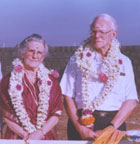 |
Flower garlands are generally offered as a mark of respect and honour.
They are offered to welcome the visitors or in honour to the Gods and
Goddesses. The garlands are generally made with white jasmine and
orange marigold flowers. They are weaved in thread tied in the end
with a knot.
|
 |
In India cow is worshipped by some section of the people and beef is not
a common item of the menu. Many Hindus are vegetarian. In South India
vegetarian dishes are served more often than non-vegetarian dishes.
Most Indians donít drink alcohol and it is not an item at the dinner
table. But it is served in some families in the cities and
big towns. Generally women donít drink alcohol.
|














